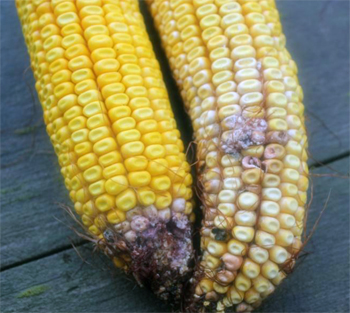Elevated levels of corn ear rots may be seen in some southern Michigan fields
Protect your grain quality and marketability this fall by scouting and properly identifying potential corn ear rots, such as gibberella and aspergillus.
With widely variable planting dates and significant drought conditions, followed by periods of heavy rainfall, corn ear rots are among the challenges that producers should keep an eye on this fall. Western bean cutworm feeding damage, which varies greatly with moth flight and the timing of flight relative to the emergence of tassels, further sets the stage for highly variable instances of corn ear rots. There is also potential in non-Bt hybrids and refuge corn for feeding damage caused by second generation European corn borer and corn earworm larvae. Corn ear rots can gain a foothold in ears that have husk and kernel damage caused by insect larval feeding.
While there may be many types of molds found in corn fields this fall, the most common mold of concern being seen is low levels of gibberella. Gibberella ear rot, a pinkish -white mold that infects kernels, is caused by the same fungus that causes Fusarium head scab of wheat. Gibberella may be more severe in continuous corn or corn following wheat. Gibberella can cause the buildup of vomitoxins that can reduce feed quality of grain and DDGs produced in ethanol production.
There is also potential for a more troubling disease, aspergillus (olive green mold), which can cause problems with aflotoxins in the grain. Aflotoxins are potent – grain contamination above 20 parts per billion can restrict use for human consumption and dairy feed. Scouting, proper identification and assessment of the incidence and severity of ear rots can be important in assuring grain quality and marketability. Kiersten Wise and Charles Woloshuk, Purdue University Department of Plant Pathology, have written an excellent pair of bulletins that explain the biology of these diseases and are referenced in the links at the end of this article.
Management practices that can reduce the impact of potential toxins and maximize grain quality going into storage are:
- Scout to know how severe fields are impacted and by what disease. Collect 10 ears from a number of locations (minimum of 30 ears) in a field prior to harvest to determine what diseases may be present. Pull back the husks and look for signs of mold. Gibberella will be present as a pink to reddish mold. Aspergillus mold will look an olive-green color. If significant amounts of ear molds are found, consider harvesting a small representative area and having the grain tested for toxin levels at an independent lab to determine your best options.
- When harvesting, adjust the combine fan, chaffer and sieve settings to “open up” the system to remove as much of the infected kernels and fines as possible. Consider using a grain cleaner at your bin to further remove fines.
- Dry the grain well (15 percent or below) before placing into storage. Drying will not denature the toxins, but can help keep the disease from infecting more kernels in the bin.
- Provide adequate cooling. Be sure to provide enough aeration in the storage bin to thoroughly cool grain and to prevent moisture migration and accumulation in the storage bin.
- Clean grain should be stored in separate bins from infected grain if possible.
- Core the bin to additionally remove fines in the vulnerable center of the bin.
- Deliver this grain to market by early spring, prior to warm-up, to limit the chance for loss of grain quality in the bin.

Ears exhibiting infection by gibberella following feeding by
western bean cutworm larvae.
References
- Diseases of Corn, Gibberella Ear Rot, Charles Woloshuk and Kiersten Wise, Purdue University Department of Botony and Plant Pathology.
- Diseases of Corn, Aspergillus Ear Rot, Charles Woloshuk and Kiersten Wise, Purdue University Department of Botony and Plant Pathology.



 Print
Print Email
Email




